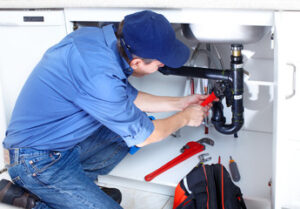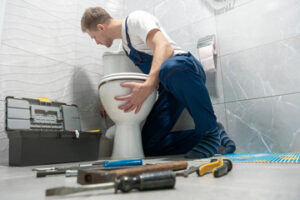Plumber Edison NJ installs and repairs systems used for potable water, hot-water production, sewage, and drainage in the home. Plumbing is a highly technical job that requires an analytical mind and problem-solving skills.

A good plumber possesses a wide range of skills, including technical prowess, continuous learning, effective communication, and exceptional customer service.
Much like fire alarms and smoke detectors, water leak detection devices help homeowners arm themselves against the disastrous effects of burst pipes, malfunctioning equipment, or flooding. While there are a variety of methods available for monitoring plumbing issues, these sensors are the most effective way to spot problems before they become costly and dangerous.
Smart leak detection systems work by observing the regular patterns of water usage, recognizing when there are spikes that indicate the presence of a leak or other abnormality. The systems then shut off the water supply to the house, severing flow from every outlet and appliance until a professional can assess the situation.
The mechanisms that determine when there’s a problem can vary, but most systems have sensors to monitor temperature changes within the pipeline, enabling them to detect whether a pipe is at risk of freezing (which can cause it to crack or burst). Some have audio-alarm-only options for warning of leaks, while others are more reactive and include shut-off valves. These are ideally installed at the point of entry to the home, which means they’ll be able to cut off the water supply immediately when they recognize that something is wrong.
Leak detection devices come in a variety of forms and prices, with whole-house systems typically costing $500-$2,500 or more. Depending on the complexity of the system and your plumber’s hourly rate, this could be a significant investment, but it can save you hundreds of dollars in damage control costs and repair fees in the long run.
There are also stand-alone leak detectors that can be installed near appliances to monitor water usage and alert the homeowner if there’s an issue. These are often less expensive and can be a good option for older homes with outdated or inefficient plumbing.
Finally, there are leak detection cables or ropes that can be used to identify issues with large areas of a house. These have a central cable around which a pair of sensing wires are concentrically wrapped, and when a conductive fluid touches both of them at once, they complete an electrical circuit and trigger an alarm. This is a great option for landlords, vacation homeowners, or property managers who need to monitor properties remotely.
Leak Noise Correlators
A leak noise correlator allows a plumber to locate a water leak in pressurised pipes, such as sewer and drainage systems without disrupting the system or shutting it down. It works by placing sensors in two locations along the pipe network at an equidistant distance from the suspected leak location and comparing them using a mathematical algorithm. The sensor data is then used to calculate how long it takes for the noise from the source to reach each of the sensors, giving a precise location of the leak within the pipe.
Leak noise correlation can work over a range of distances from 20 to 300 meters on a pipe network, depending on the type of pipe and conditions. It can be used to identify primary or secondary leaks on houses connections, hydrants, meters or water mains. However, it is important to remember that correlation will not find all leaks, especially in older, plastic pipes, so listening sticks should also be employed where possible.
The technology behind leak noise correlation was developed in the 1970s, much like the first personal computers were. Back then, these devices were about 10 or even 20 times larger than the modern versions. However, they have now become a highly effective and accurate way to locate leaks.
In the case of a leak, it is essential for a plumber to be able to locate it quickly and accurately. This is because once the leak has been located, it is easier to access and repair, reducing overall project costs. Moreover, the use of leak noise correlation can reduce water wastage and associated environmental impacts.
The latest generation of acoustic leak detection systems offer exceptional performance for both small and large diameter pipes, including those made from plastic. In addition, they are able to pinpoint leaks over longer distances than previous technology. These features make this equipment ideal for use on water networks, especially those with high water pressures and a large number of joints. The advanced leak detection software is able to run multiple automated combinations, filtering out all but the most specific and relevant information to produce accurate results in less time. In addition, a quality assessment feature provides a high degree of confidence for each correlation, helping the operator to pinpoint the leak with ease and accuracy.
Pressure Gauges
Pressure gauges are a staple tool for plumbing professionals. They are easy to read, durable, and provide a reliable means of troubleshooting hydraulic systems and power equipment. They are also available in a wide variety of configurations, making them suitable for most applications. Some common types of pressure gauge include sanitary gauges, explosion-proof gauges, and vacuum gauges. Each type of gauge has its own advantages and disadvantages.
Most analog (mechanical) pressure gauges rely on precision mechanical linkages. The most common technology is a Bourdon tube, invented in 1849, which moves — or more precisely, slightly uncoils — as pressure changes the dimensions of its helical, circular cross-section. This movement is transmitted to a display mechanism via a series of gears and linkages, typically moving a pointer across a dial to indicate the pressure being measured. Other types of analog gauges include diaphragm and bellows gauges, which work similarly.
Digital pressure gauges, on the other hand, use electronic sensors to convert the physical motion of a sensing element into a digital signal. This is accomplished through the use of a microprocessor, resulting in a more accurate and stable digital display.
Regardless of their design, both analog and digital pressure gauges must be inspected regularly for signs of damage or wear. They must also be kept filled with glycerine or silicone to reduce the risk of damage due to vibration and shock. The type of fluid used in a system and its temperature range will also affect the accuracy of the gauge. In addition, the manufacturer’s recommendations for calibration intervals should be followed.
In order to ensure that the pressure gauge is in working condition, it is important to verify its accuracy by connecting it to a well-regulated pressurized system and running a test procedure. The results of this test should be compared to the calibration readings on the gauge, which are indicated on the back of the instrument. Regular recalibrating is also recommended, although it can be a much quicker process with a digital gauge than an analog gauge.
Plumbing Inspections
Plumbing inspections cover all of the components in your home or business’s water piping system to ensure they are functioning correctly. During the process, plumbers check for a variety of issues such as leaks, corrosion, clogs, drainage problems and more. This can help ensure your pipes are delivering water and waste properly and prevent damage to your property in the future.
The benefits of plumbing inspections can include early detection of problems, lower water and power bills, improved drainage efficiency, peace of mind and more. Professional plumbers have the knowledge, experience and tools to thoroughly assess your plumbing system and recommend any necessary repairs or maintenance.
Leaks, clogs and other common problems can be expensive to repair, but routine maintenance and inspections can help keep your plumbing in good condition and reduce costly breakdowns. Regular plumbing maintenance can also extend the life of your pipes and fixtures, saving you money in the long run.
When you schedule a plumbing inspection, your plumber will complete a visual evaluation of your plumbing to identify any issues. This will include checking all of your water supply pipes for signs of damage, rust or leaks, as well as assessing the quality of your water and determining the pressure of your water flow. They may also inspect your sump pump, check appliance connections and assess the state of your water heater.
In addition, plumbers can use specialised tools and equipment to examine hard-to-reach areas of your plumbing system like underground pipes, sewer lines and behind walls. In addition, they can provide you with a detailed report of their findings and recommend any necessary repairs.
Plumbing inspections are an important part of any homeowner’s maintenance routine, especially for older homes or commercial buildings with old pipe materials. By conducting regular plumbing inspections, you can catch problems before they escalate and save yourself from costly repairs and potential structural damage to your home or business. In addition, plumbing inspections can help you plan for the future by identifying any older pipes that are nearing their end of life and recommend replacement to avoid costly repairs or disasters.

